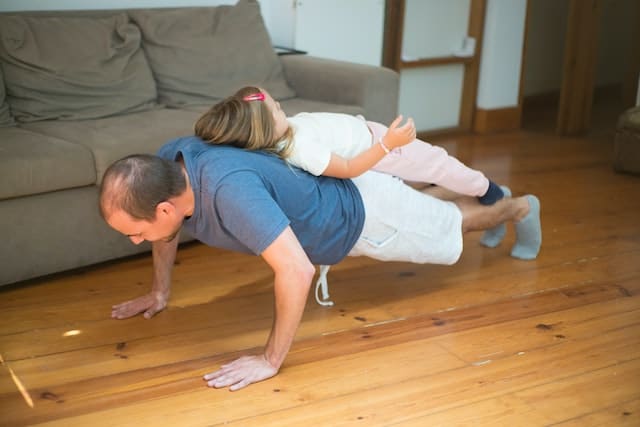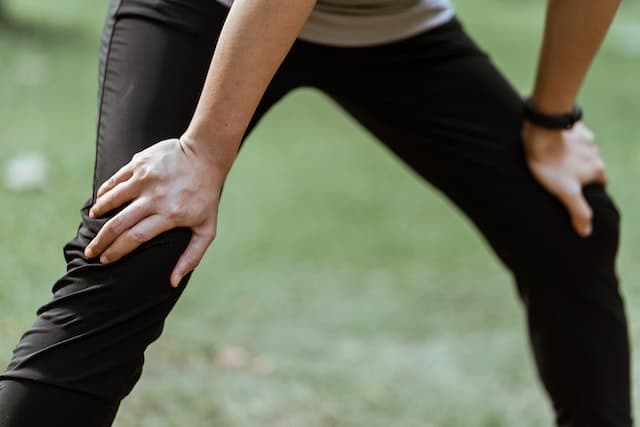First published: 14 April 2023 @ 6:00 pm
3. Use Resistance Bands or Light Weights to Add Variety and Intensity to Your Workout
If you are looking for an affordable and versatile way to increase the intensity of your at-home workouts, consider incorporating resistance bands or light weights.
Resistance bands can add variety to bodyweight exercises and provide a challenging workout for your muscles.
Light weights can be used for a range of exercises, including bicep curls, squats, and lunges, to further engage your muscles and ramp up the intensity of your workouts.
When incorporating resistance bands or weights into your routine, it is important to start with lighter weights or bands to prevent injury and gradually increase the intensity and weight as your strength improves.
Incorporating resistance bands or light weights into your beginner workouts can help you see results faster and make your at-home workouts more interesting and challenging.
4. Focus on Proper Form to Avoid Risk of Injury and Maximize the Effectiveness of Each Exercise
It is essential to prioritize proper form when performing any exercise, especially for beginners.
Good form is important not only to maximize the effectiveness of each exercise but also to prevent injuries.
As a beginner, it may be tempting to perform exercises quickly and with a lot of energy, but it’s essential not to sacrifice form for speed.
Before starting any workout routine, take the time to learn the proper form for each exercise.
You can consult with a trainer or watch videos of professionals performing the exercises correctly to ensure you’re doing them the right way.
Proper form ensures that you’re targeting the right muscles, avoiding incorrect muscle imbalances, and reducing the risk of injury.
5. Aim for Consistency by Committing to a Regular Workout Schedule
As a beginner starting out with workouts at home, consistency is key to achieving your fitness goals.
Aim to commit to a regular workout schedule that suits your lifestyle and gradually increase the duration and intensity of your workouts.
The key to long-term success is to start small and work your way up as you progress. This approach not only helps you to build a solid foundation of fitness but also minimizes the risk of injury.
Start with simple exercises such as basic bodyweight movements, cardio activities, and light resistance training.
Once you are comfortable with these movements, gradually increase the duration and intensity of your workouts to challenge your body and continue to see results.
Remember, consistency over time is key to achieving your fitness goals and maintaining a healthy lifestyle.

Final Thoughts
Working out at home can be a great option for beginners who are just starting their fitness journeys or those who prefer to exercise in the comfort of their own space.
By incorporating the above-mentioned workouts into your routine, you can start building strength, increasing flexibility, and improving your overall health and fitness.
Remember to start slow, listen to your body, and gradually increase the intensity and duration of your workouts.
With consistency and dedication, you can achieve your fitness goals right from the comfort of your own home.
If you find this article helpful, share this with your beloved friends or family and subscribe to our blog TriviaViral for more articles about physical health and fitness!
FAQs
Should I workout every day as a beginner?
As a beginner, it is not recommended to work out every day. Working out every day can lead to injury and burnout, especially for beginners who are not used to regular exercise. So, it’s important to listen to your body and only work out if you feel like you can handle it.
How long should beginners workout?
There is no set duration for how long beginners should work out, as each person’s body is different and will respond differently to different types of exercise. However, 30 to 40 minutes of workout per session, with regular breaks between sets to stretch and recover is a good guideline to start with.
How do I start exercising daily?
Starting to exercise daily can be challenging, but there are some tips that can help. First, identify your “why” and set realistic goals. Then, start slowly and build up gradually to avoid injury, and incorporate some light cardio into your routine.
What is the best time to workout?
Different people have different schedules and preferences, so what works best for one person may not work as well for another. Some people prefer to work out early in the morning before the rest of the world is awake, while others may prefer to work out in the evening after they’ve had some time to relax. The key is to find a time that works for you and stick to it.
What happens if I exercise every day?
If you exercise every day, you’ll likely see results in a relatively short amount of time. However, if you’re new to working out, it’s important to allow your body time to adjust and build muscle. A good rule of thumb is to start out by exercising three times per week and gradually increase the frequency as you become more comfortable and confident with your routine.

